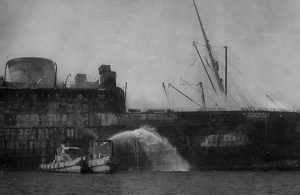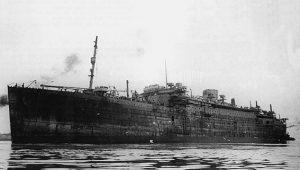 On 7th July 1941 Georgic arrived at Port Tewfik. Troops and matériel were offloaded and by 13th July evacuees and returning troops were boarding. In the early hours of 14th July air raid sirens sounded. Initially the German bombers concentrated on shore installations then the ships in Suez Roads, especially Georgic. One bomb exploded alongside after bouncing off the hull, the shock wave damaged hull plating and caused flooding in No. 4 hold. The next bomb hit the sports deck, plunged through a lift shaft and exploded five decks down in No. 5 hold.
On 7th July 1941 Georgic arrived at Port Tewfik. Troops and matériel were offloaded and by 13th July evacuees and returning troops were boarding. In the early hours of 14th July air raid sirens sounded. Initially the German bombers concentrated on shore installations then the ships in Suez Roads, especially Georgic. One bomb exploded alongside after bouncing off the hull, the shock wave damaged hull plating and caused flooding in No. 4 hold. The next bomb hit the sports deck, plunged through a lift shaft and exploded five decks down in No. 5 hold.
 Fire broke out on all five decks, fed by fuel oil escaping from a ruptured tank in the double bottom. Within 20 minutes the fire reached ammunition in Holds No. 7 and 8, which exploded. Georgic was now listing to port with extensive flooding. About a dozen of the gun crew were killed or injured. The steering was jammed, and Georgic crashed into HMS Glenearn, anchored nearby. With great difficulty Captain Greig managed to ground on North Reef, clearing the channel. Georgic lay abandoned and was left to burn. The ship was gutted, her midships destroyed by the fuel fire, and her stern wrecked by the explosion.
Fire broke out on all five decks, fed by fuel oil escaping from a ruptured tank in the double bottom. Within 20 minutes the fire reached ammunition in Holds No. 7 and 8, which exploded. Georgic was now listing to port with extensive flooding. About a dozen of the gun crew were killed or injured. The steering was jammed, and Georgic crashed into HMS Glenearn, anchored nearby. With great difficulty Captain Greig managed to ground on North Reef, clearing the channel. Georgic lay abandoned and was left to burn. The ship was gutted, her midships destroyed by the fuel fire, and her stern wrecked by the explosion.
 On 17th July Captain Greig and a group of engineers returned to see what was left. Superstructure was distorted: the engines were undamaged, but under water. Commander J.G. Wheeler, Mediterranean Fleet Salvage Officer, arrived from Haifa on 17th July. He had to wait for a professional diver to assess the underwater damage. On 14th September it was decided that Georgic could be raised and saved, and on 15th September the salvage ship Confederate arrived at Suez, along with a professional salvage team and divers. Pumps were acquired and patches were made for the doors and portholes that were underwater. Cmdr Wheeler gave the order on 10th October to start pumping water out. Initially they worked on the engine room and stern holds so that the weight of the water in the forward end kept the wreck securely on the reef. By 27th October Georgic was afloat, and Confederate towed the wreck to an anchorage. Make-shift repairs were completed, and temporary pumps installed to keep the water levels down.
On 17th July Captain Greig and a group of engineers returned to see what was left. Superstructure was distorted: the engines were undamaged, but under water. Commander J.G. Wheeler, Mediterranean Fleet Salvage Officer, arrived from Haifa on 17th July. He had to wait for a professional diver to assess the underwater damage. On 14th September it was decided that Georgic could be raised and saved, and on 15th September the salvage ship Confederate arrived at Suez, along with a professional salvage team and divers. Pumps were acquired and patches were made for the doors and portholes that were underwater. Cmdr Wheeler gave the order on 10th October to start pumping water out. Initially they worked on the engine room and stern holds so that the weight of the water in the forward end kept the wreck securely on the reef. By 27th October Georgic was afloat, and Confederate towed the wreck to an anchorage. Make-shift repairs were completed, and temporary pumps installed to keep the water levels down.
On 29th December Georgic left for Port Sudan, under tow from Clan Campbell, with Ellerman’s City of Sydney steering from astern, as no tugs were available. The rudder was still jammed hard over, making her veer wildly while under tow. On 3rd January 1942 the tow rope from Georgic to City of Sydney snapped as gales swept the area. On 7th January a tug arrived from Port Sudan, and a new tow line was passed to City of Sydney. The small convoy eventually arrived at Port Sudan on 10th January. Georgic spent the next seven weeks at Port Sudan, for repairs to reduce the list, and the rudder was freed from the jammed position.
It was decided to take Georgic to Karachi. On 5th March Harrison Line’s Recorder was requisitioned for the tow, with the tug Sampson steering from astern, for the 2,775 mile journey. On 6th March severe weather forced Sampson to break off the tow, and soon after the tug sank. On 8th March British India’s Haresfield took over the aft steering position and later the tug Pauline Moller assisted. On 1st April Georgic arrived at Karachi, for further repairs. The interiors were cleaned of all remaining debris, the distorted stem straightened and the engines cleaned and coaxed back to life. Georgic left Karachi under her own steam on 11th December, for Bombay, arriving two days later. Further repairs were completed, and the hull was cleaned. After a brief stop at Cape Town from 5th to 8th February to refuel and reprovision, Georgic arrived at Liverpool on 1st March.
 At Liverpool, surveyors from the Admiralty and the Ministry of War Transport surveyed Georgic to determine her fate. On 16th March it was decided to rebuild her as a permanent troopship, and for Cunard-White Star to manage her. She arrived at Harland & Wolff in Belfast on 19th March. On 5th July the No. 3 berth at Musgrave Yard was freed: Georgic was transferred and the work of restoring her began. Internally she was completely rebuilt. Externally the dummy forward funnel was removed, the foremast reduced and the mainmast cut off, with just a small signal mast added. Georgic left Belfast on 16th December 1944 for Liverpool, to resume her trooping duties.
At Liverpool, surveyors from the Admiralty and the Ministry of War Transport surveyed Georgic to determine her fate. On 16th March it was decided to rebuild her as a permanent troopship, and for Cunard-White Star to manage her. She arrived at Harland & Wolff in Belfast on 19th March. On 5th July the No. 3 berth at Musgrave Yard was freed: Georgic was transferred and the work of restoring her began. Internally she was completely rebuilt. Externally the dummy forward funnel was removed, the foremast reduced and the mainmast cut off, with just a small signal mast added. Georgic left Belfast on 16th December 1944 for Liverpool, to resume her trooping duties.
